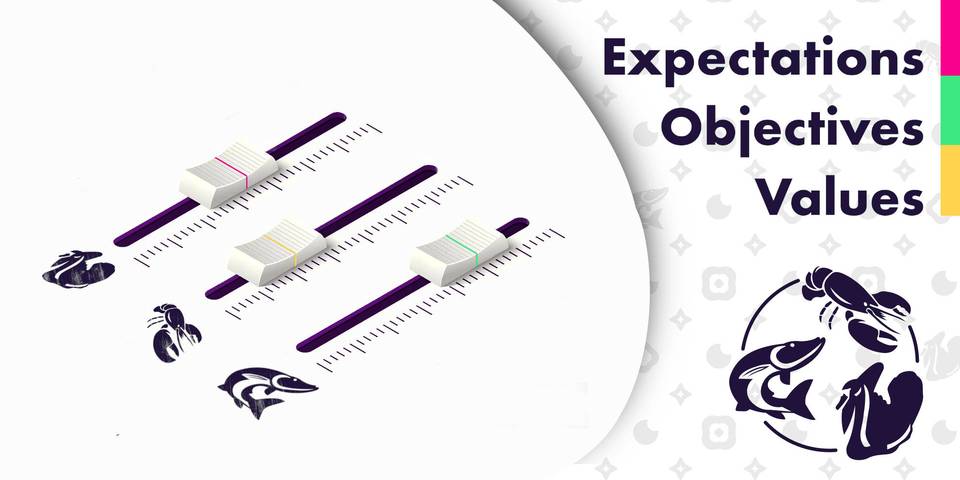I think the following fable by Ivan Krylov (translated by yours truly) illustrates the point of alignment better than anything. Please read it prior to going through my contemplations on the subject at hand.
To dig even deeper I would suggest learning about the SCP model and how it helps with qualifying business decisions.
A Swan, a Crawfish and a Pike.
When partners act without accord
Their deed will not concord.
And soon the work feels rather torment-like.
One day, a swan, a crawfish and a pike
Resolved to haul a cart with load.
Got harnessed, three of them, as one, prepared to hit the road.
Exerting ‘selves inside and out; the cart — it will not budge.
The load seems light, about right size,
But swan is rushing towards skies,
The crawfish does a backwards trudge, to waters pike pulls with a nudge.
Now, who was right and who was wrong —
‘Tis not for us to say,
But bear in mind — the cartload’s there
Until this very day.
Defining objectives, values and expectations
First, let me define what I mean by values, expectations and objectives in this article.
Business objectives are the goals set by the management of the company aimed at getting to a better future state. I am mostly referring to the profits as one of the most common ones. But there could be a plethora of other business objectives that require alignment as well, such as: the number of leads and prospects; followings, reach and engagement on social media; talent acquisition, etc.
Company values are the reasons and motivations behind the actions of employees who are responsible for the execution of business objectives.
Customer expectations are the hopes and suppositions of clients in regard to the scope and quality of services as well as experiences they are anticipating to procure from a vendor.
The sustainable future of the company is more likely to be achieved when employees are motivated in exceeding customer expectations while meeting business objectives. That motivation stems from the culture within the company which is embedded in company values.
What if there is a misalignment?
In short — everyone suffers. With questionable culture comes low morale. When employees suffer, they will neither execute on the business objectives nor put in the effort to meet customers’ expectations. When clients suffer, they will not return. When the business suffers due to the above and, in addition, to low profit margins, sooner rather than later the company would have to be shut down.
An example of misalignment
One day, on my way back from a retail store I used to run, I have decided to have a haircut at one of the well-know, expensive beauty salons in a mall, letting my regular hairdresser take a well-deserved break. The price at the spot was three times the price of my regular hair cut, but what the heck. . . Interiors, space, lighting, floors, mirrors and chairs — everything was clean, cosy and welcoming; everything suggested a premium service which, I bet, I deserved. It seemed convenient too.
The interaction with a lovely hair stylist soon turned into a sort of blame and shame process with a verdict. The moment her scissors touched my blonde strands she had started a never-ending series of complaints — outrageous statements about the abnormality of the way my hair grows and how hard it was going to be for her to get her job done. Huffing and puffing, she had compared my precious lockets with the impossibility of her husbands’ hair. Not only had I not been acquainted to her husband, I wasn’t sure the comparison was justifiable. Luckily — as of today — I haven’t had the honor of meeting her husband or his hair.
Should I mention that since then — more than 10 years ago — I have never been to and have no intention whatsoever of visiting any of the many company’s locations in the foreseeable future? That company has failed to align my (customer) expectations with their values. I’m sure the profits were there, but they did not translate that into the training of the employee who had performed the job poorly. I wouldn’t recommend this place to anyone. I didn’t like my haircut either.
How to make alignment work?
Here are a few examples that should help you with tackling the problem of misalignment.
- If the key decision makers at your company value high-quality services per se and expertise in general, don’t offer your company’s services at prices lower than or just-as-low-as the bulk of the cheap, cursory competition. Your costs are going to be higher, making your firm less profitable. Look for existing clients whose expectations match the level of your quality and expertise. If there are none, create them.
- If the management of your company values inexpensive services above all else don’t put a high price tag. The higher the price, the higher the customer expectations. High customer expectations will not play well with the business objective of extraterrestrial profit margins based on lowest possible costs. Make sure the low price guarantees normal profits and clients are happily paying for the value you actually deliver (instead of claiming to provide).
- If customer expectations are high but their budget is low either walk away from this business opportunity or try to lower their expectations while still maintaining your profit margins. You should not compromise on your values by offering something of quality lower than you normally do. Your customers will not be happy anyway and you will not be able to make money — a typical lose-lose scenario. If customer expectations are low, make sure you are able to make a profit without jeopardizing your values.
- If profits are low, improve the quality and increase prices for your services while insuring a buy-in from your employees. Find clients who are ready to pay premium for a different kind of service where the initial perception of expectations might be higher making it exciting for clients to try something new yet proven.
- If profits are already high make sure to exceed customer expectations by introducing more value to your services, while building on and thus reinforcing the values of your company.
I am purposefully refraining from suggesting an increase in profits through a degeneration of your integrity or lowering the costs via ruthless compromises on the quality — any fool can do that and you’re not one of them.
The alignment of objectives to values to expectations means the ability to provide services at the level that guarantees profits at the quality level your company believes to be sufficient to at least meet (if not exceed) the expectations of your customers.
When a business entity fails to align all three, not only will it eventually fail but it is already failing at a different, higher level of analysis. This is about the connivance. If the job isn’t done right, there will be redoes, replacements and repairs — all of that involves production and procurement of stuff that wouldn’t have to be produced should the company have performed the services responsibly in the first place; not to mention the frustrations and an additional strain on client’s budget.
If you find yourself working for the company where connivance is a daily routine, it’s a sure sign of imminent failure. Regardless, the kind of attitude from within the company could only attract exactly the same scheming agents, partners and clients who share that sort of value coordinate system, directing it towards your own firm.
Final thoughts
On the path of alignment, it’s best to start with your company values first and then move your way toward aligning customer expectations and business objectives. The value systems of your key decision makers will set the tone for everyone at the firm. The culture you create on a daily basis will spread further out and impact how you run things, how you position yourselves, how you produce, market and price your services and how you interact with your clients.
You will be making business decisions non-stop. The quality of these decisions will compound and produce a sum total. It can be in the negative or null too. Consider applying the SCP model to qualify your business decisions.
The awezzom question of the day:
How can we achieve alignment between our company values, business objectives and customer expectation?

